

- © 2003 - 2025 Dynamix Productions, Inc. Contact Us 0



- Lt. Werner: What's going on? Why are we diving?
- 2nd Lieutenant: Hydrophone check. At sea, even in a storm you can hear more down here than you can see up there.”
Das Boot
Everybody knows Popeye the Sailor Man, right? I worshipped that cartoon when I was a little kid. I even went around with a little spinach-packed container tucked into my waste-band and picked fights, just so I could eat the spinach before throwing punches - true story. There were many impossible feats beyond my spinach-fueled superpowers that only Popeye could do, and one of them was to yell for help while trapped under the sea. In one cartoon, Bluto (who else but that disgustipatin' brute) traps Popeye on the sea bottom with nothing but the air in his lungs. When Popeye yells for help, a large bubble comes out of his mouth, floats to the surface, and his "Help!" is then heard coming out of the water.
Funny stuff, but now there's a hint of reality in that scene. In the near future, submarines might be using sound waves to communicate through ocean waves. Intriguing, but let's first look at the history of how submarines communicate, problems they face, and why this emerging technology may be the new wave of submerged communications.
The early advancement of submarines almost parallels the advancement of radio. In fact, submarines helped advance early two-way radio communications by taking part in trials of shore-to-ship radio communications. Interesting side note: In World War One my great-uncle George Cassidy served on one of these submarines, the USS Snapper, that had conducted those early radio trials before the war. At the time of the experiments, the Snapper was commanded by Lieutenant Chester W. Nimitz (yes, that Nimitz, the WWII Pacific Fleet Commander-in-Chief).
Back in the early days of submarines and radio, transmitters could only manage to broadcast low frequency radio waves which required massive antennas and enormous amounts of power. Only large naval ships could accommodate the bulky compliment of radio broadcasting equipment, so submarines could "receive" only. As radio technology improved, radio frequencies got higher, shorter, and had more fidelity. The Navy soon found out that when submarines were deeper than a few hundred feet, saltwater limited transmitting and receiving these higher and smaller radio waves, so submarines stuck with the older-style VLF (Very Low Frequencies, 3 to 30,000 Hz) band for receiving only. A land-based transmitter might signal a "come to the surface" message for submarines, then use traditional radio bands for two-way communication, which can be risky if they want to remain undetected.
Later technology allowed submarines to monitor yet a lower radio band, ELF (Extremely Low Frequencies, 3 to 300 Hz), that penetrated the water even deeper, and from farther away. ELF radio waves can easily travel the globe, either by direct wave or by skipping off the upper atmosphere. The problem with ELF is the real estate and power needed to send such a signal. Any radio wave lower than 30,000 Hz has a ginormous wavelength of 10 kilometers or larger. During World War Two, the Nazis built the Goliath Antenna network in northwestern Germany that could signal any U-boat 20 meters deep, no matter where they were in the world. The system used three 688-foot antennas (half as tall as the Empire State Building) and more than 200 miles of cable (the distance from Lexington to Nashville). The transmitter sucked up 1,000 Kilowatts (the same power that 500 modern households use). After the war, the Soviets dismantled Goliath and installed it near Moscow. The U.S., Britain, and other naval powers had or are still using similar technology. China, which has the world's largest submarine fleet (at last count 111 subs vs 67 American subs) has a New York City-sized ELF transmitter that also triples as a deep earth ore locator for mining, and as an earthquake warning system.
But this technology is very limited for raw communications. VLF has a digital transmission speed of about 200 bits per second (bps) and ELF about 2 bps. For comparison, old-style dial-up internet was about 28,800 bps. That's just barely fast enough for Popeye to Morse-code "SOS." Always looking for an edge, the military developed a type of laser communications in the 1980s. The submarine would direct a weak optical laser beam containing data upwards through the water to an overhead aircraft. Recent experiments show even more promise using adapted fiber technology called Quantum Key Distribution (QKD) that allows subs to be even deeper and stealthier, transmit to satellite, and have full quantum-level encryption at no loss of data speed. Another interesting program has placed underwater modems operating in the 900 to 60,000 Hz band for relaying data between ships and headquarters, though saltwater limits these to a range of 17 miles.
The next submarine technology that will make a big splash is: TARF!!! Or more mundanely: Translational Acoustic-RF Communication. When an acoustic signal is generated under water, it travels as a pressure wave. In fact, sound travels more efficiently in liquids than it does in air, simply because the molecules are closer together and bump into each other more easily. Comparing sound waves moving in water to those in air is kind of like a big crowd at a ballgame doing the wave, versus the same people trying it while social-distancing a hundred feet apart - awkward and inefficient. Anyway, this acoustic wave travels to the surface where the water meets air. At that water-air boundary, tiny displacements occur. These are essentially very tiny ripples that are smaller than typical ocean waves.
These small vibrations or ripples are then detected by very sensitive airborne radar that scans the surface of the water. So far, experiments have been successful with waves as high as 6 1/2 inches and 100,000 times larger than the acoustical ripples. The 400 bps data rate is pretty slow, but a lot faster than current VLF and ELF. Will this be the next big thing for the Navy? It's still in the experimental stage right now, so I defer to the wise old salty sailor Popeye for his opinion. He would probably say, “Leave us not jump to seclusions.” Well blow me down!